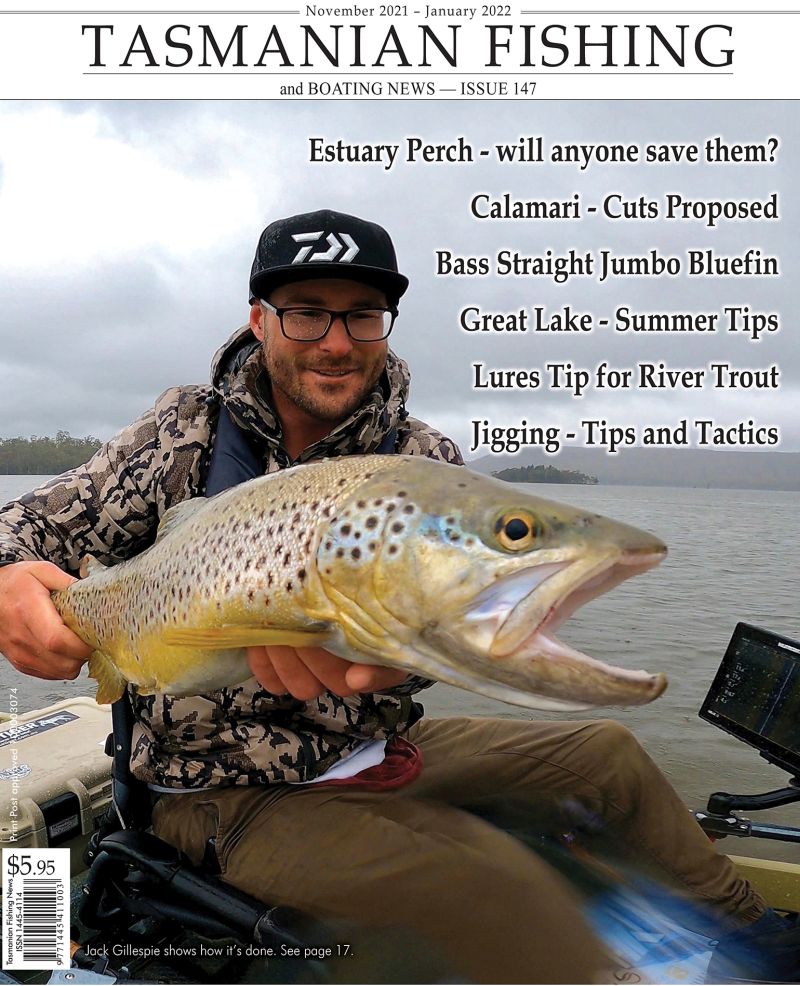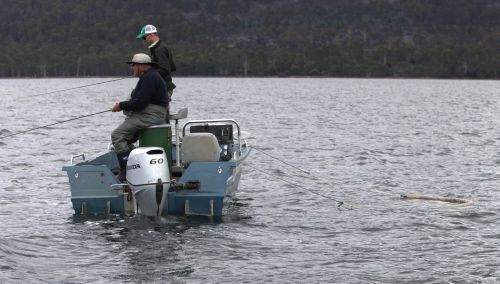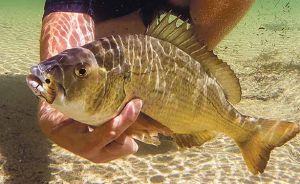 Presented from Issue 109, April 2014
Presented from Issue 109, April 2014
April is an exciting month in Tasmania, the weather becomes much more stable with less wind and as far as our estuaries are concerned there is an abundance of fish species on offer and Georges Bay in St Helens is one of the best. This year will see the annual Tasmanian Family Fishing Festival happening again on the waters of St Helens on Saturday April the 26th. To help budding anglers along I have put together a few hints and tips on where to fish and what to use for the species that you will be targeting. This certainly applies for Georges Bay in April and May, so even if you can’t make the Fishing Festival come down for a few days anyway. Jamie Henderson
The shore based species for this years Tasmanian Family Fishing Festival are Leatherjacket, Yellow Eyed Mullet and Silver Trevally.
These species can be caught all throughout Georges Bay from both the Jetties and sections of shoreline.
Georges Bay has a good variety of shore fishing options from sandy flats to rocky shores as well as the many small jetties around the bay and these offer a great place to start. To ensure a successful outing on a wharf or jetty the use of berley is paramount, this will attract fish from a wide area to your fishing position and keep them there for your session.
A small berley pot with a couple of handfuls of berley pellets and a capful or two of tuna oil is all that is needed and dropped down a foot or two under the surface.
Try not to introduce large amounts of berley to the water column at once as this will only serve to feed the fish and they will soon move on, the effect you are looking for is a constant, steady stream of particles floating down to the bottom……a little bit often is better than a lot at once, a few handfuls tossed liberally around the general area will also serve to attract fish from a wider environment.
Once the berley has attracted schools of fish to your area then a standard paternoster rig, small bomb sinker on the bottom with two hooks above, dropped to the bottom is by far the best all-purpose rig to use.
Place a piece of bait on each hook such as prawn flesh, S.A. Pippies or King Bait Squid Strips and the action should come thick and fast.
As many of the fish feed on the small bait fish that frequent Georges Bay, at times the water around the jetty’s can be black with bait fish, the use of small baitfish imitation lures and soft plastics can be very effective.
Just a simple cast and retrieve with an erratic motion will be all that’s needed. Some great plastics to try are the Yep Tassie Tackle 3” flick baits as well as the Z-Man 2.5” grubs.
Some areas to concentrate on are the main wharf area towards the main township, the small T-Bar shaped jetty in Beauty Bay just along the waterfront, Kerwins jetty along the shoreline a little further from Beauty Bay (both of these can be seen from the road driving into St Helens) and both the Parkside and O’Conner’s Beach jetty out along the road to St Helens Point. All of these jetties produce good fish on a regular basis.
If a jetty or wharf is not your thing then there is plenty of good wadable shoreline to concentrate on. Starting in the township a quick wander along the foreshore and around the main wharf along the rocks can produce good fish, I find that a small soft plastic outfit is an ideal way to target these areas and flicking small bait fish imitations up along the pylons and along the rock walls will produce fish as well as unweighted baits being let drift about naturally.
As you move over the bridge on your way out of the town there is a small oyster encrusted rock wall that you can climb down to at low tide, this gives casting access to the pylons under the bridge and the rock wall itself can quite often hold good numbers of fish.
From this point almost all the way around the waterfront is a walking/bike track and from here you can access quite a lot of good fishable shoreline with a good mixture of rocky bottom, sandy shore and muddy flats.
Here the same soft plastic outfits and lures will work well or a simple running sinker rig of a small ball sinker down to a #6-#2 long shank style hook, baits such as those mentioned above will be ideal for these areas as well.
When looking for a likely spot to target with the baits I prefer the shorelines that have some shallow mud or sand flats close by that have plenty of small crab and nipper holes in them as this is where the fish will feed as the tide rises over them.
Target the drop offs on the edges of these flats when the tide is low and fish up on the shallows as the tide rises over them.
One of my favourite areas in the bay to do this is the Stockyard Flats near Akaroa. It is easily accessible by car, has a good little parking area and is easy to wade, just being careful to keep your eye on the tide when it rushes in over the mudflats.
The Trevally and Mullet will come right up on the edges and the Leatherjacket will stay just down over the edge of the drop off just on the edge of the weed beds.
For the boat based anglers this year the species being targeted are Black Bream, Australian Salmon, Flathead and Garfish.
One of the most important factors to successful Garfishing is the use of berley to attract the fish and keep them in the immediate vicinity of your boat. By far the most effective and lethal berley I have come across is a premixed berley that is in a fine particle form that resembles breadcrumbs but has some added attractants mixed in for good measure. I mix 2 handfuls of the berley mix and half a cupful of tuna oil to a berley pot and lower over the side of the boat; this creates a cloud of fine particles in the water as well as an oil slick on the surface.
As there are no large food items for the garfish to feed on they tend to swim around getting a good whiff of the berley and oil and become quite agitated and enter into a feeding frenzy. Provided you keep a continuous stream of this berley mixture in the water the fish will stay attracted to the area for long enough to catch your feed. A small size10-12 long shank hook under a small quill or ball float with a small piece of squid.
Garfish tend to favour areas that are shallow and have good seagrass beds, in Georges Bay the hot spot seems to be along the red channel markers leading out to the barway next to the shallow sandbank.
Here you have shallow water, plenty of seagrass and on the incoming tide some good current to carry your berley trail and keep the fish swimming behind your boat.
I have found that the incoming tide from about half in to full tide is about the best time to chase the Gars.
The garfish can often be seen swimming right up on the shallow sand flats also and large schools of fish will jump out of the water as if they are being chased by something larger.
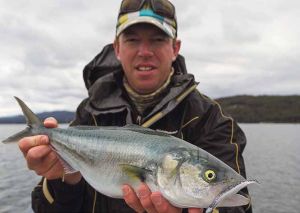 Australian Salmon respond well to a number of different baits such as bluebait, whitebait, squid, pippies and prawns but “matching the hatch” is always your best option and if the fish are chasing bait schools then the smaller fish bait is best.
Australian Salmon respond well to a number of different baits such as bluebait, whitebait, squid, pippies and prawns but “matching the hatch” is always your best option and if the fish are chasing bait schools then the smaller fish bait is best.
While the salmon are focused on the bait schools it is prime time to target the fish with artificial means such as metal lures and soft plastics.
When the Salmon schools are boiling on the surface a few different techniques can be employed, by far the most common is trolling lures behind a boat, whilst this seems an easy method it is by far not the most effective as the noise from the outboard motors tends to put the schools down and move them around too much.
A far more deadly and effective method is drift spinning, by this I mean motoring up wind or up current of the school of fish switching the motor off and drifting down onto the fish casting lures or soft plastics ahead of you, this keeps the school up on top and quite often you end up right in the middle of the school with fish all around you.
The boat itself can also act as a large F.A.D. (fish attracting device) as it casts a large shadow in the water and the baitfish quite often try and find refuge underneath keeping the school of salmon all around your boat.
The Salmon tend to roam the bay following the bait but likely spots to start are the main channel leading out to the barway and the Moulting Bay area, all the while keeping a lookout for hovering birds and pelicans on the move.
When the Salmon are marauding a bait school simply casting out a soft plastic and letting it sink down slowly will usually result in a hookup if not either a straight retrieve back to the boat or a twitch- and-drop retrieve will be effective.
I have had some great success lately using both Squidy Whip Baits as well as the Z-Man 4.75” Streakz soft plastics, both of these resemble the small baitfish that the Salmon have been feeding on almost prefectly.
With the many sand flat and mud flat areas around Georges Bay it is of no surprise that good numbers of Flathead can be caught.
As the tide rises the fish will move up onto the flats feeding on all manner of items such as small crabs and crustaceans, prawns, shrimps, sandworms, nippers and small baitfish all being dispersed as the water floods the new ground.
As the tide recedes the Flathead will sit on the drop offs and gutters on the outer edges of the flats waiting in ambush of any tasty morsel moving past them.
It is at this stage that the angler has the best chance of capture as the fish will attack nearly anything that moves past it, baits such as King Bait squid strips, S.A. pippies and prawns are all good.
Flathead respond well to bait that is moving so a slow drift over the flats or a slow retrieve sliding the bait across the bottom will be very effective.
The Flathead are also a prime species for targeting with soft plastics and from my experience this technique results in much larger than average fish most of the time.
My favourite plastics lures for this method are #2 and #3 Squidgy Fish in Gary Glitter, Killer Tomato and Mint Jelly or #3 and #4 Squidgy Wriggler in Wasabi and Gary Glitter. Sitting up on the mud and sand flats in 2-5 metres of water is ideal and the technique involves casting out as far as possible and letting the lure fall to the bottom, then a quick lift and drop hopping it all the way back to the boat, every now and then throwing in an aggressive whip into the retrieve to get the attention of any interested fish nearby.
 Bream move around all over the bay, hanging around wharfs, jetty’s, moored boats, oyster racks feeding and all over the expanses of sand and mudflats exposed at low tide. They feed heavily on the rich barnacles, mussels and small crustaceans that abound in these areas and grow fat and powerful. Once again effective use of berley will attract schools of fish to your area, baits such as peeled prawn flesh and S.A. pippies work well as do freshly pumped nippers and small black crabs.
Bream move around all over the bay, hanging around wharfs, jetty’s, moored boats, oyster racks feeding and all over the expanses of sand and mudflats exposed at low tide. They feed heavily on the rich barnacles, mussels and small crustaceans that abound in these areas and grow fat and powerful. Once again effective use of berley will attract schools of fish to your area, baits such as peeled prawn flesh and S.A. pippies work well as do freshly pumped nippers and small black crabs.
A standard running ball sinker rig is ideal combined with an octopus style hook in sizes #6 through to #2 to match the bait being used. Also unweighted baits drifted down the berley trail will not be refused by a hungry little bream.
Small Bream are abundant all around the bay near any sort of structure and will keep the kids occupied all day, however if its larger specimens you are after than targeting them with soft plastics and hard body bibbed lures is for you. Plastics such as 80mm & 100mm Pro Range Squidgy Wrigglers in Wasabi, Bloodworm and Evil Minnow are all dynamite on Georges Bay Bream. Area’s to concentrate are around any structure, wharfs, jetties, pylons, oyster racks, moored boats and shallow rocky points.
One of my favourite areas for bream is the extensive sand flats and mudflats throughout the bay, some of the biggest schools and largest Bream come from up on the shallow sand and mudflats in less than 1 metre of water. One of my favourite techniques for this area, so long as there is very little weed, is the use of hard body lures. Lures worthy of a cast are Strike Pro Smelta, Bass-X and Pygmy styles all in various colours as well as the new Cranka Minnow in both shallow and deep models.
I start with a basic long cast and slow winding retrieve back letting the lure just bounce its bib across the sand.
If this does not bring a strike from a fish then a pause every now and then and small twitches in the retrieve may trigger the Bream to attack the lure, once hooked on the shallows the Bream will peel line off your reel and carve up the flats testing the light tackle to its limits.
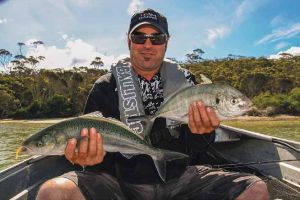
Hopefully the information above helps you land a few good fish on the day and we hope to see you there with rod in hand ready for a great day’s family fun on the water.
Jamie Henderson


